Leadership and Operational Management Strategies at Starbucks Report
VerifiedAdded on 2021/02/21
|18
|5226
|110
Report
AI Summary
This report provides a detailed analysis of leadership and management practices at Starbucks, examining the roles of leaders and managers, comparing their characteristics, and exploring their functions within the organization. The report delves into various leadership theories, including trait theory, style theory, situational leadership, transformational leadership, and transactional leadership, illustrating how these theories are applied within Starbucks. It also explores different management theories such as scientific and bureaucratic theories. Furthermore, the report analyzes how leadership and management are applied in different situational contexts, such as interpersonal conflicts and task allocation. It evaluates the application of operations management, including key approaches and the importance of efficiency improvements. The report considers factors within the business environment that impact operational management and concludes with an evaluation of the effectiveness of leadership and management strategies at Starbucks.
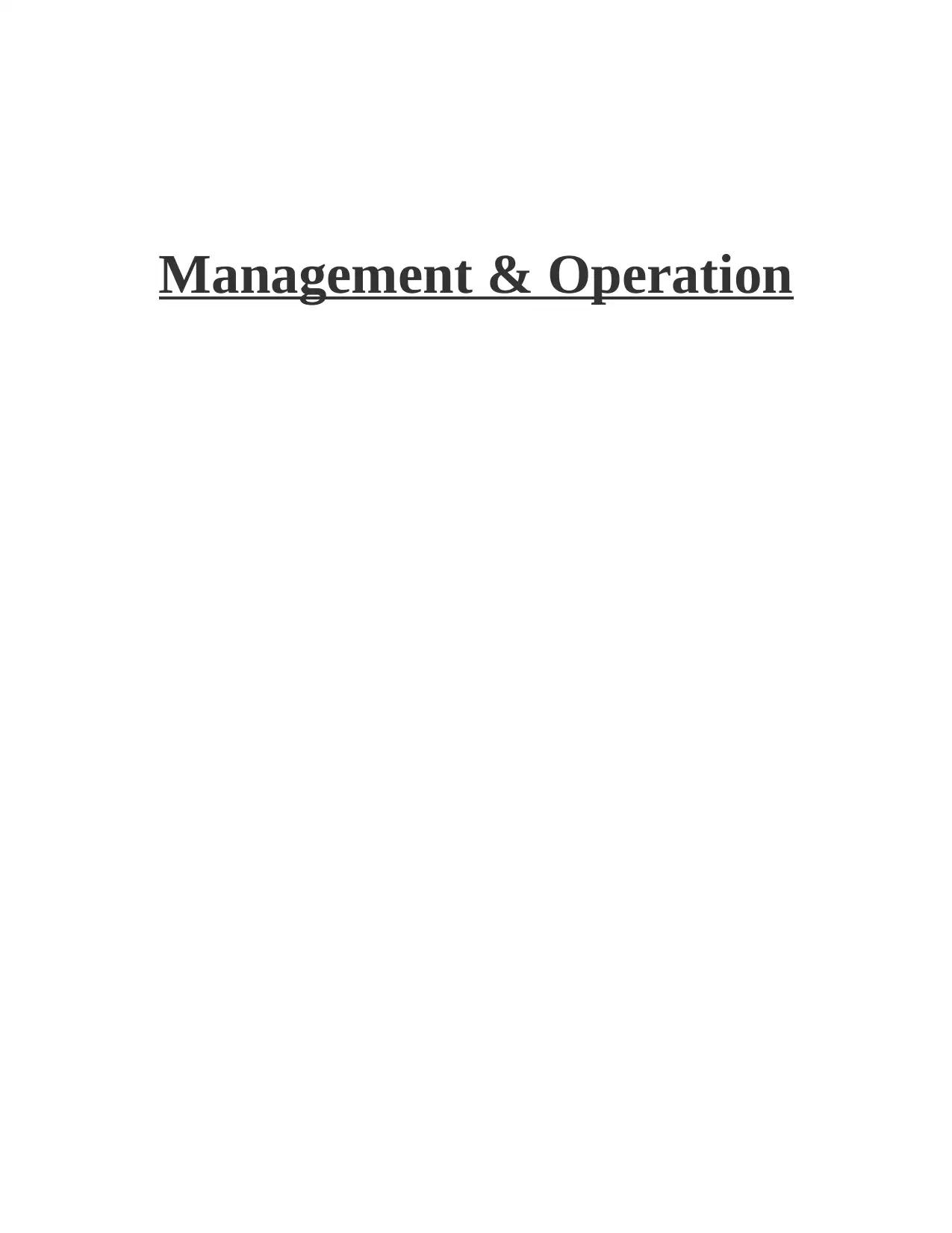
Management & Operation
Paraphrase This Document
Need a fresh take? Get an instant paraphrase of this document with our AI Paraphraser
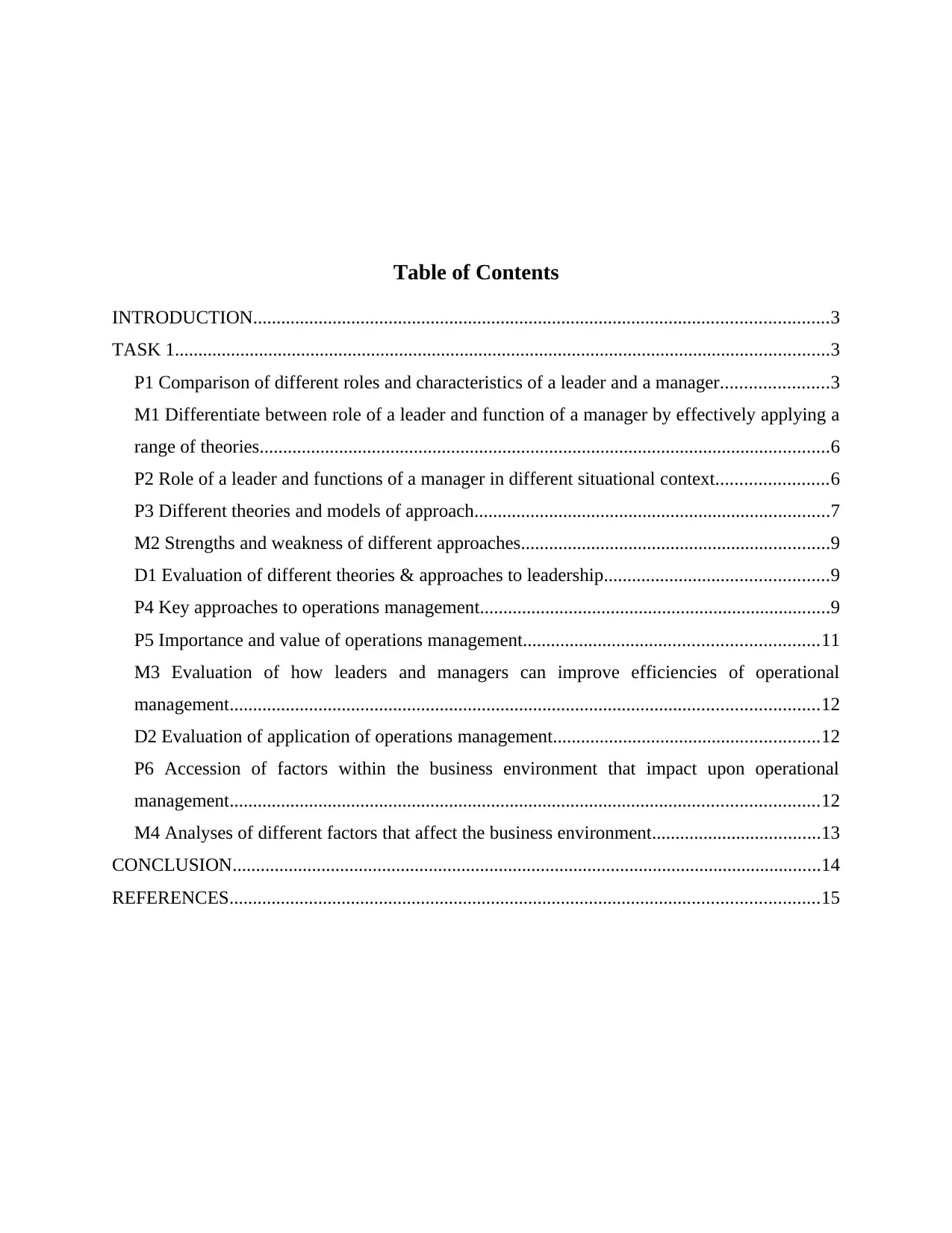
Table of Contents
INTRODUCTION...........................................................................................................................3
TASK 1............................................................................................................................................3
P1 Comparison of different roles and characteristics of a leader and a manager.......................3
M1 Differentiate between role of a leader and function of a manager by effectively applying a
range of theories..........................................................................................................................6
P2 Role of a leader and functions of a manager in different situational context........................6
P3 Different theories and models of approach............................................................................7
M2 Strengths and weakness of different approaches..................................................................9
D1 Evaluation of different theories & approaches to leadership................................................9
P4 Key approaches to operations management...........................................................................9
P5 Importance and value of operations management...............................................................11
M3 Evaluation of how leaders and managers can improve efficiencies of operational
management..............................................................................................................................12
D2 Evaluation of application of operations management.........................................................12
P6 Accession of factors within the business environment that impact upon operational
management..............................................................................................................................12
M4 Analyses of different factors that affect the business environment....................................13
CONCLUSION..............................................................................................................................14
REFERENCES..............................................................................................................................15
INTRODUCTION...........................................................................................................................3
TASK 1............................................................................................................................................3
P1 Comparison of different roles and characteristics of a leader and a manager.......................3
M1 Differentiate between role of a leader and function of a manager by effectively applying a
range of theories..........................................................................................................................6
P2 Role of a leader and functions of a manager in different situational context........................6
P3 Different theories and models of approach............................................................................7
M2 Strengths and weakness of different approaches..................................................................9
D1 Evaluation of different theories & approaches to leadership................................................9
P4 Key approaches to operations management...........................................................................9
P5 Importance and value of operations management...............................................................11
M3 Evaluation of how leaders and managers can improve efficiencies of operational
management..............................................................................................................................12
D2 Evaluation of application of operations management.........................................................12
P6 Accession of factors within the business environment that impact upon operational
management..............................................................................................................................12
M4 Analyses of different factors that affect the business environment....................................13
CONCLUSION..............................................................................................................................14
REFERENCES..............................................................................................................................15
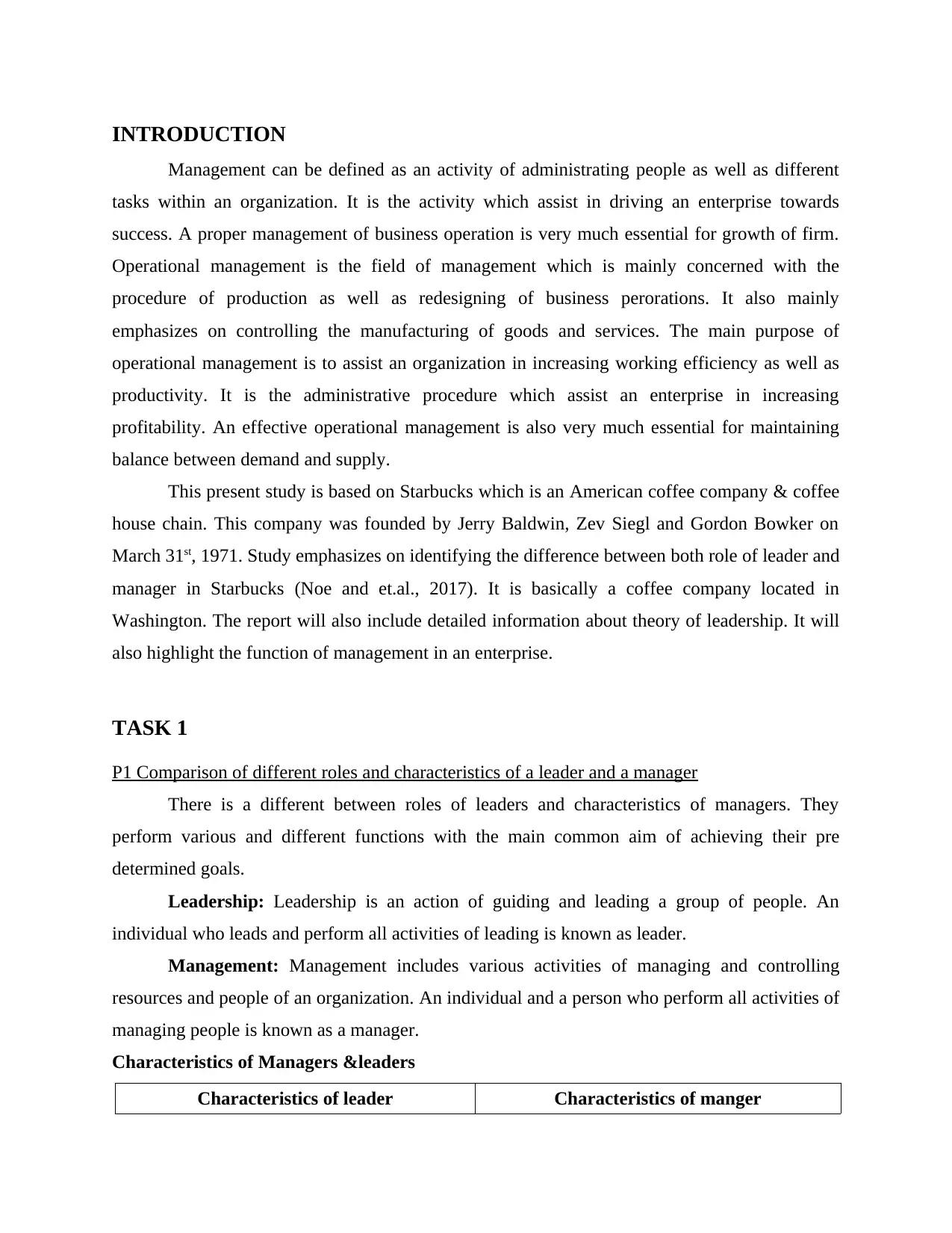
INTRODUCTION
Management can be defined as an activity of administrating people as well as different
tasks within an organization. It is the activity which assist in driving an enterprise towards
success. A proper management of business operation is very much essential for growth of firm.
Operational management is the field of management which is mainly concerned with the
procedure of production as well as redesigning of business perorations. It also mainly
emphasizes on controlling the manufacturing of goods and services. The main purpose of
operational management is to assist an organization in increasing working efficiency as well as
productivity. It is the administrative procedure which assist an enterprise in increasing
profitability. An effective operational management is also very much essential for maintaining
balance between demand and supply.
This present study is based on Starbucks which is an American coffee company & coffee
house chain. This company was founded by Jerry Baldwin, Zev Siegl and Gordon Bowker on
March 31st, 1971. Study emphasizes on identifying the difference between both role of leader and
manager in Starbucks (Noe and et.al., 2017). It is basically a coffee company located in
Washington. The report will also include detailed information about theory of leadership. It will
also highlight the function of management in an enterprise.
TASK 1
P1 Comparison of different roles and characteristics of a leader and a manager
There is a different between roles of leaders and characteristics of managers. They
perform various and different functions with the main common aim of achieving their pre
determined goals.
Leadership: Leadership is an action of guiding and leading a group of people. An
individual who leads and perform all activities of leading is known as leader.
Management: Management includes various activities of managing and controlling
resources and people of an organization. An individual and a person who perform all activities of
managing people is known as a manager.
Characteristics of Managers &leaders
Characteristics of leader Characteristics of manger
Management can be defined as an activity of administrating people as well as different
tasks within an organization. It is the activity which assist in driving an enterprise towards
success. A proper management of business operation is very much essential for growth of firm.
Operational management is the field of management which is mainly concerned with the
procedure of production as well as redesigning of business perorations. It also mainly
emphasizes on controlling the manufacturing of goods and services. The main purpose of
operational management is to assist an organization in increasing working efficiency as well as
productivity. It is the administrative procedure which assist an enterprise in increasing
profitability. An effective operational management is also very much essential for maintaining
balance between demand and supply.
This present study is based on Starbucks which is an American coffee company & coffee
house chain. This company was founded by Jerry Baldwin, Zev Siegl and Gordon Bowker on
March 31st, 1971. Study emphasizes on identifying the difference between both role of leader and
manager in Starbucks (Noe and et.al., 2017). It is basically a coffee company located in
Washington. The report will also include detailed information about theory of leadership. It will
also highlight the function of management in an enterprise.
TASK 1
P1 Comparison of different roles and characteristics of a leader and a manager
There is a different between roles of leaders and characteristics of managers. They
perform various and different functions with the main common aim of achieving their pre
determined goals.
Leadership: Leadership is an action of guiding and leading a group of people. An
individual who leads and perform all activities of leading is known as leader.
Management: Management includes various activities of managing and controlling
resources and people of an organization. An individual and a person who perform all activities of
managing people is known as a manager.
Characteristics of Managers &leaders
Characteristics of leader Characteristics of manger
⊘ This is a preview!⊘
Do you want full access?
Subscribe today to unlock all pages.

Trusted by 1+ million students worldwide
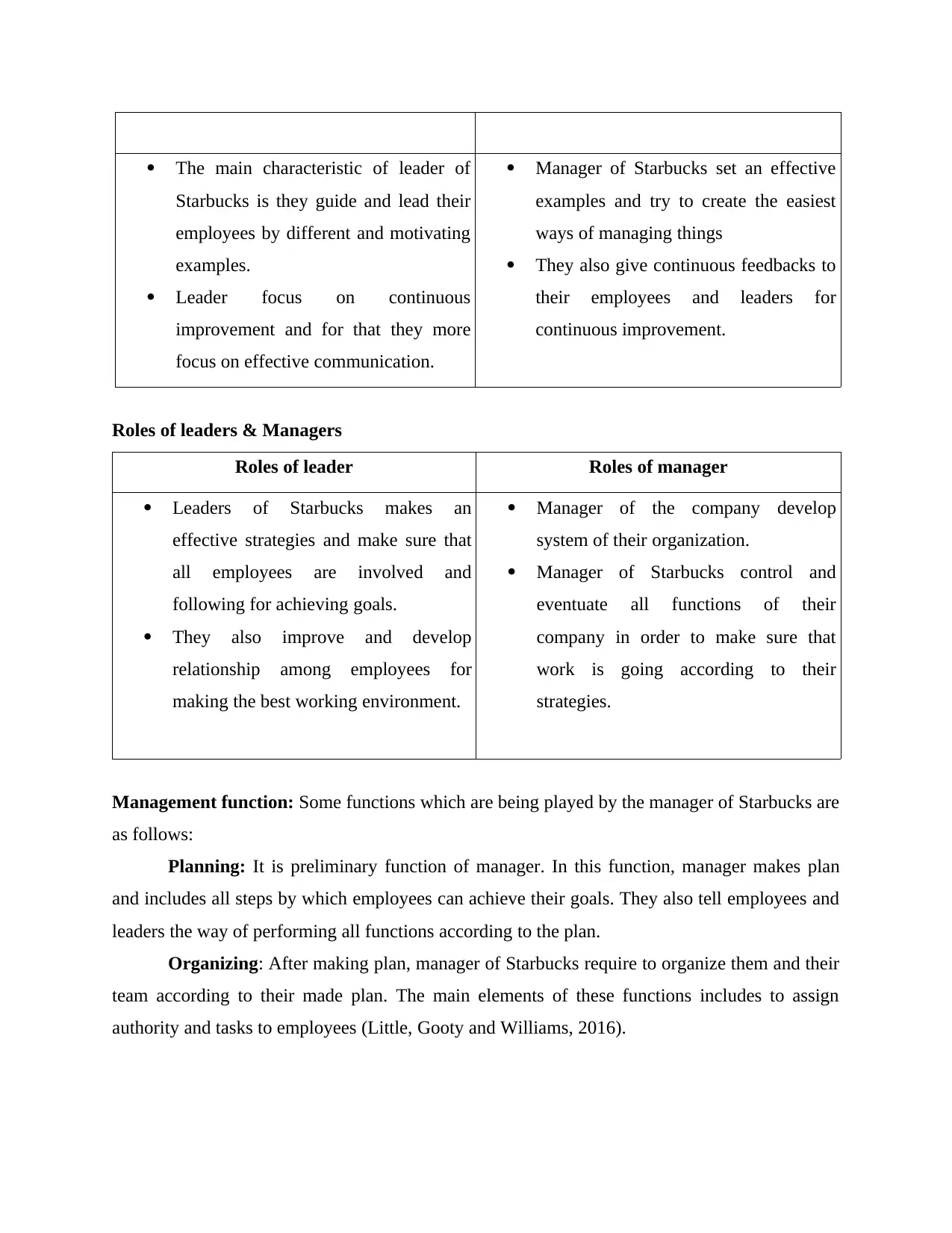
The main characteristic of leader of
Starbucks is they guide and lead their
employees by different and motivating
examples.
Leader focus on continuous
improvement and for that they more
focus on effective communication.
Manager of Starbucks set an effective
examples and try to create the easiest
ways of managing things
They also give continuous feedbacks to
their employees and leaders for
continuous improvement.
Roles of leaders & Managers
Roles of leader Roles of manager
Leaders of Starbucks makes an
effective strategies and make sure that
all employees are involved and
following for achieving goals.
They also improve and develop
relationship among employees for
making the best working environment.
Manager of the company develop
system of their organization.
Manager of Starbucks control and
eventuate all functions of their
company in order to make sure that
work is going according to their
strategies.
Management function: Some functions which are being played by the manager of Starbucks are
as follows:
Planning: It is preliminary function of manager. In this function, manager makes plan
and includes all steps by which employees can achieve their goals. They also tell employees and
leaders the way of performing all functions according to the plan.
Organizing: After making plan, manager of Starbucks require to organize them and their
team according to their made plan. The main elements of these functions includes to assign
authority and tasks to employees (Little, Gooty and Williams, 2016).
Starbucks is they guide and lead their
employees by different and motivating
examples.
Leader focus on continuous
improvement and for that they more
focus on effective communication.
Manager of Starbucks set an effective
examples and try to create the easiest
ways of managing things
They also give continuous feedbacks to
their employees and leaders for
continuous improvement.
Roles of leaders & Managers
Roles of leader Roles of manager
Leaders of Starbucks makes an
effective strategies and make sure that
all employees are involved and
following for achieving goals.
They also improve and develop
relationship among employees for
making the best working environment.
Manager of the company develop
system of their organization.
Manager of Starbucks control and
eventuate all functions of their
company in order to make sure that
work is going according to their
strategies.
Management function: Some functions which are being played by the manager of Starbucks are
as follows:
Planning: It is preliminary function of manager. In this function, manager makes plan
and includes all steps by which employees can achieve their goals. They also tell employees and
leaders the way of performing all functions according to the plan.
Organizing: After making plan, manager of Starbucks require to organize them and their
team according to their made plan. The main elements of these functions includes to assign
authority and tasks to employees (Little, Gooty and Williams, 2016).
Paraphrase This Document
Need a fresh take? Get an instant paraphrase of this document with our AI Paraphraser
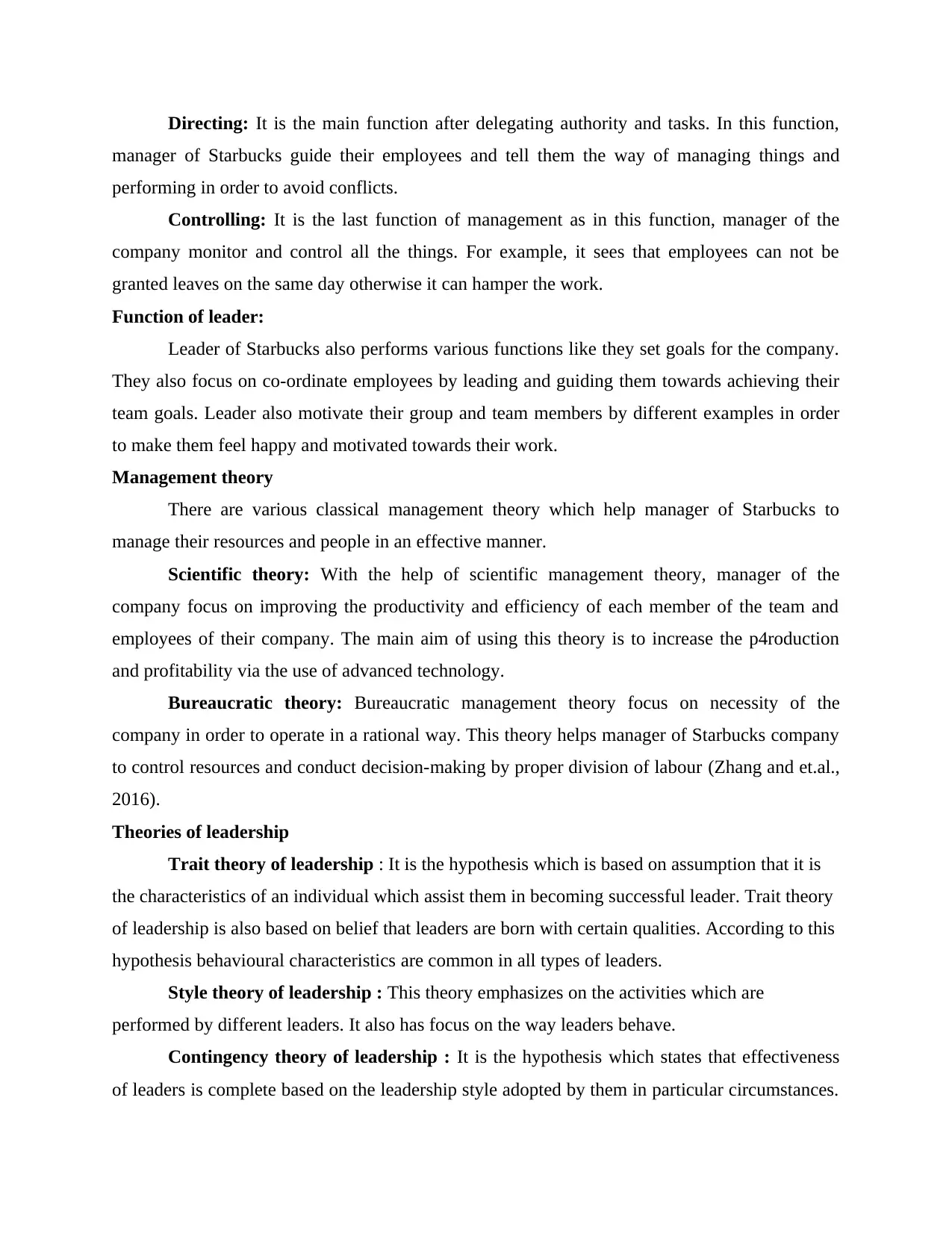
Directing: It is the main function after delegating authority and tasks. In this function,
manager of Starbucks guide their employees and tell them the way of managing things and
performing in order to avoid conflicts.
Controlling: It is the last function of management as in this function, manager of the
company monitor and control all the things. For example, it sees that employees can not be
granted leaves on the same day otherwise it can hamper the work.
Function of leader:
Leader of Starbucks also performs various functions like they set goals for the company.
They also focus on co-ordinate employees by leading and guiding them towards achieving their
team goals. Leader also motivate their group and team members by different examples in order
to make them feel happy and motivated towards their work.
Management theory
There are various classical management theory which help manager of Starbucks to
manage their resources and people in an effective manner.
Scientific theory: With the help of scientific management theory, manager of the
company focus on improving the productivity and efficiency of each member of the team and
employees of their company. The main aim of using this theory is to increase the p4roduction
and profitability via the use of advanced technology.
Bureaucratic theory: Bureaucratic management theory focus on necessity of the
company in order to operate in a rational way. This theory helps manager of Starbucks company
to control resources and conduct decision-making by proper division of labour (Zhang and et.al.,
2016).
Theories of leadership
Trait theory of leadership : It is the hypothesis which is based on assumption that it is
the characteristics of an individual which assist them in becoming successful leader. Trait theory
of leadership is also based on belief that leaders are born with certain qualities. According to this
hypothesis behavioural characteristics are common in all types of leaders.
Style theory of leadership : This theory emphasizes on the activities which are
performed by different leaders. It also has focus on the way leaders behave.
Contingency theory of leadership : It is the hypothesis which states that effectiveness
of leaders is complete based on the leadership style adopted by them in particular circumstances.
manager of Starbucks guide their employees and tell them the way of managing things and
performing in order to avoid conflicts.
Controlling: It is the last function of management as in this function, manager of the
company monitor and control all the things. For example, it sees that employees can not be
granted leaves on the same day otherwise it can hamper the work.
Function of leader:
Leader of Starbucks also performs various functions like they set goals for the company.
They also focus on co-ordinate employees by leading and guiding them towards achieving their
team goals. Leader also motivate their group and team members by different examples in order
to make them feel happy and motivated towards their work.
Management theory
There are various classical management theory which help manager of Starbucks to
manage their resources and people in an effective manner.
Scientific theory: With the help of scientific management theory, manager of the
company focus on improving the productivity and efficiency of each member of the team and
employees of their company. The main aim of using this theory is to increase the p4roduction
and profitability via the use of advanced technology.
Bureaucratic theory: Bureaucratic management theory focus on necessity of the
company in order to operate in a rational way. This theory helps manager of Starbucks company
to control resources and conduct decision-making by proper division of labour (Zhang and et.al.,
2016).
Theories of leadership
Trait theory of leadership : It is the hypothesis which is based on assumption that it is
the characteristics of an individual which assist them in becoming successful leader. Trait theory
of leadership is also based on belief that leaders are born with certain qualities. According to this
hypothesis behavioural characteristics are common in all types of leaders.
Style theory of leadership : This theory emphasizes on the activities which are
performed by different leaders. It also has focus on the way leaders behave.
Contingency theory of leadership : It is the hypothesis which states that effectiveness
of leaders is complete based on the leadership style adopted by them in particular circumstances.
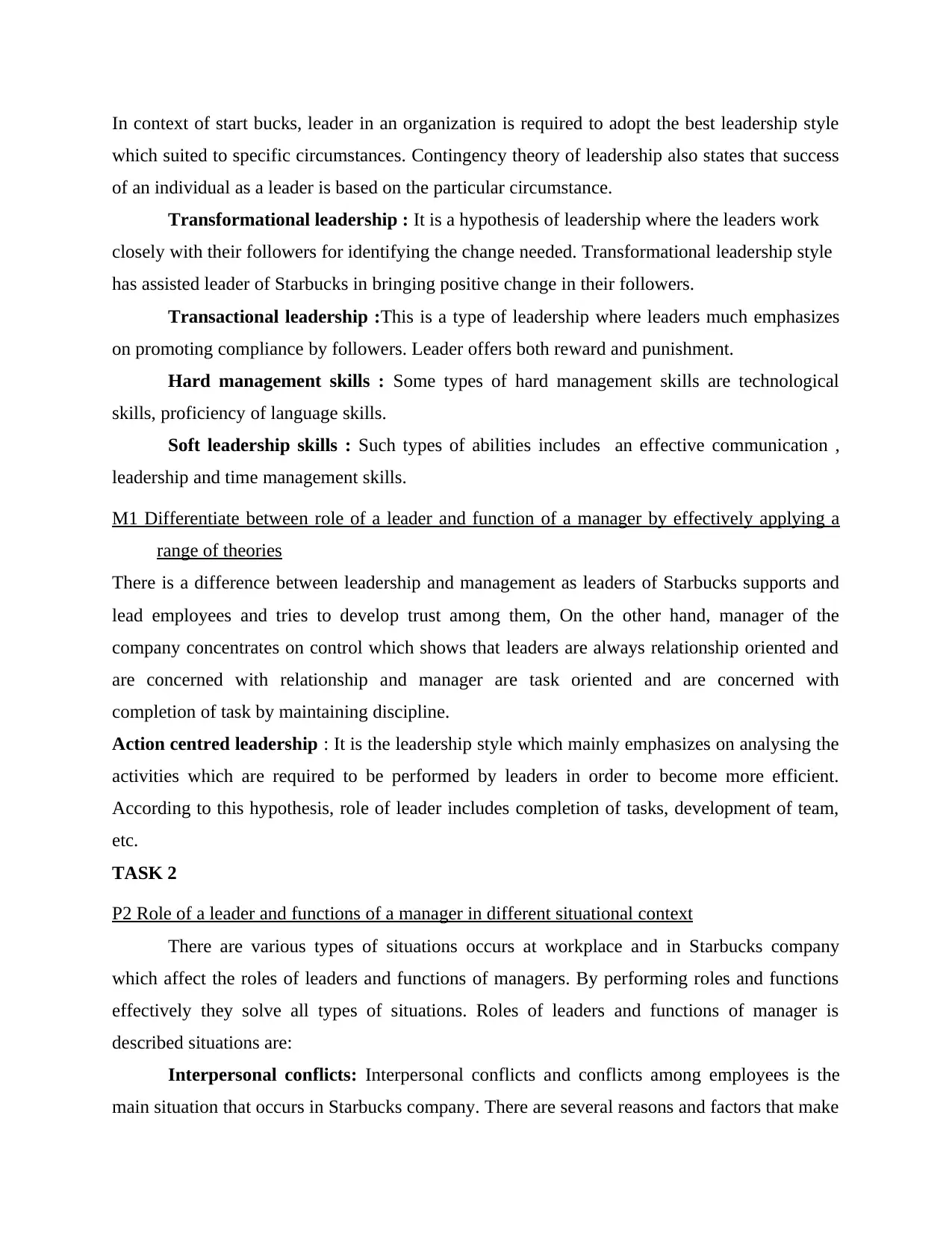
In context of start bucks, leader in an organization is required to adopt the best leadership style
which suited to specific circumstances. Contingency theory of leadership also states that success
of an individual as a leader is based on the particular circumstance.
Transformational leadership : It is a hypothesis of leadership where the leaders work
closely with their followers for identifying the change needed. Transformational leadership style
has assisted leader of Starbucks in bringing positive change in their followers.
Transactional leadership :This is a type of leadership where leaders much emphasizes
on promoting compliance by followers. Leader offers both reward and punishment.
Hard management skills : Some types of hard management skills are technological
skills, proficiency of language skills.
Soft leadership skills : Such types of abilities includes an effective communication ,
leadership and time management skills.
M1 Differentiate between role of a leader and function of a manager by effectively applying a
range of theories
There is a difference between leadership and management as leaders of Starbucks supports and
lead employees and tries to develop trust among them, On the other hand, manager of the
company concentrates on control which shows that leaders are always relationship oriented and
are concerned with relationship and manager are task oriented and are concerned with
completion of task by maintaining discipline.
Action centred leadership : It is the leadership style which mainly emphasizes on analysing the
activities which are required to be performed by leaders in order to become more efficient.
According to this hypothesis, role of leader includes completion of tasks, development of team,
etc.
TASK 2
P2 Role of a leader and functions of a manager in different situational context
There are various types of situations occurs at workplace and in Starbucks company
which affect the roles of leaders and functions of managers. By performing roles and functions
effectively they solve all types of situations. Roles of leaders and functions of manager is
described situations are:
Interpersonal conflicts: Interpersonal conflicts and conflicts among employees is the
main situation that occurs in Starbucks company. There are several reasons and factors that make
which suited to specific circumstances. Contingency theory of leadership also states that success
of an individual as a leader is based on the particular circumstance.
Transformational leadership : It is a hypothesis of leadership where the leaders work
closely with their followers for identifying the change needed. Transformational leadership style
has assisted leader of Starbucks in bringing positive change in their followers.
Transactional leadership :This is a type of leadership where leaders much emphasizes
on promoting compliance by followers. Leader offers both reward and punishment.
Hard management skills : Some types of hard management skills are technological
skills, proficiency of language skills.
Soft leadership skills : Such types of abilities includes an effective communication ,
leadership and time management skills.
M1 Differentiate between role of a leader and function of a manager by effectively applying a
range of theories
There is a difference between leadership and management as leaders of Starbucks supports and
lead employees and tries to develop trust among them, On the other hand, manager of the
company concentrates on control which shows that leaders are always relationship oriented and
are concerned with relationship and manager are task oriented and are concerned with
completion of task by maintaining discipline.
Action centred leadership : It is the leadership style which mainly emphasizes on analysing the
activities which are required to be performed by leaders in order to become more efficient.
According to this hypothesis, role of leader includes completion of tasks, development of team,
etc.
TASK 2
P2 Role of a leader and functions of a manager in different situational context
There are various types of situations occurs at workplace and in Starbucks company
which affect the roles of leaders and functions of managers. By performing roles and functions
effectively they solve all types of situations. Roles of leaders and functions of manager is
described situations are:
Interpersonal conflicts: Interpersonal conflicts and conflicts among employees is the
main situation that occurs in Starbucks company. There are several reasons and factors that make
⊘ This is a preview!⊘
Do you want full access?
Subscribe today to unlock all pages.

Trusted by 1+ million students worldwide
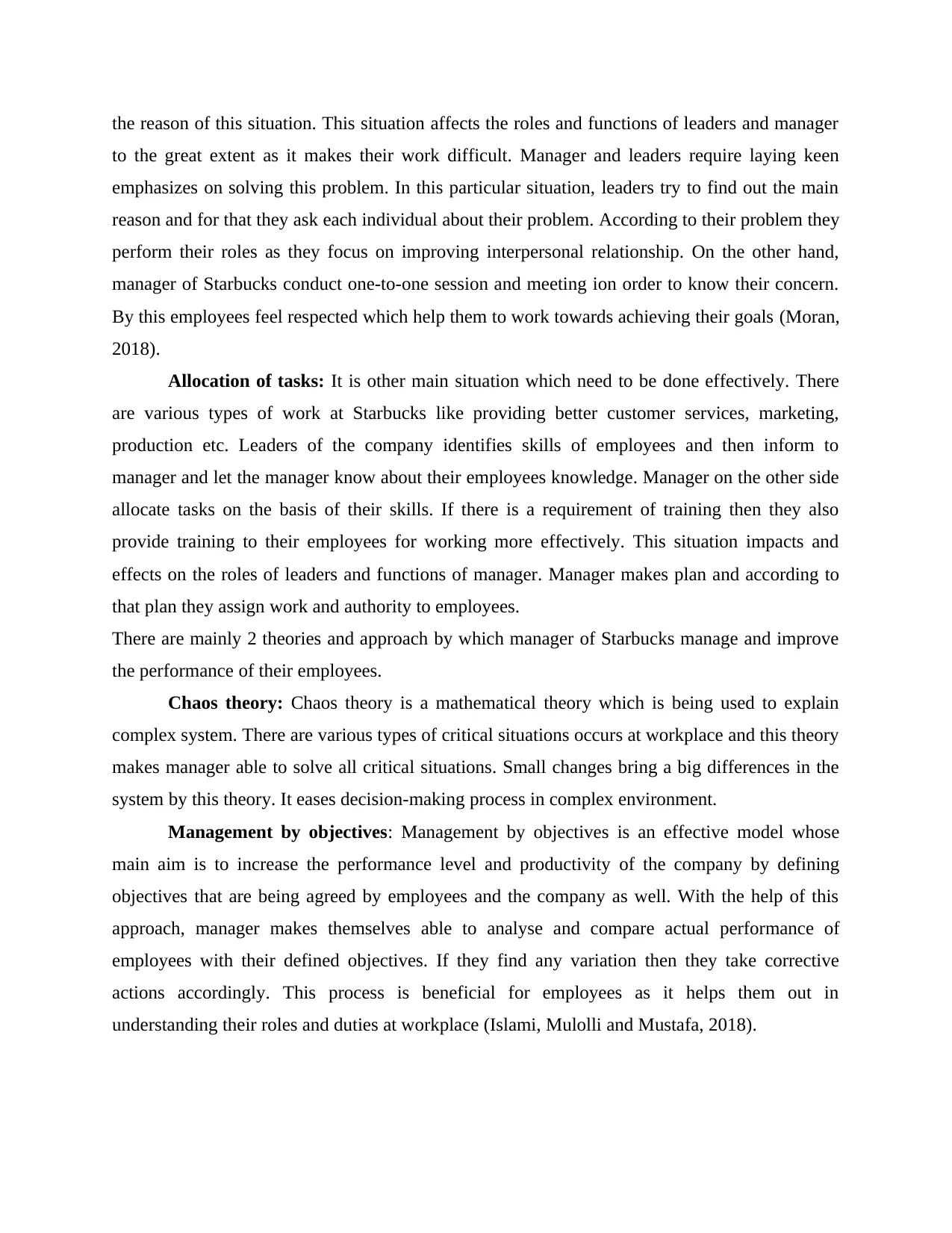
the reason of this situation. This situation affects the roles and functions of leaders and manager
to the great extent as it makes their work difficult. Manager and leaders require laying keen
emphasizes on solving this problem. In this particular situation, leaders try to find out the main
reason and for that they ask each individual about their problem. According to their problem they
perform their roles as they focus on improving interpersonal relationship. On the other hand,
manager of Starbucks conduct one-to-one session and meeting ion order to know their concern.
By this employees feel respected which help them to work towards achieving their goals (Moran,
2018).
Allocation of tasks: It is other main situation which need to be done effectively. There
are various types of work at Starbucks like providing better customer services, marketing,
production etc. Leaders of the company identifies skills of employees and then inform to
manager and let the manager know about their employees knowledge. Manager on the other side
allocate tasks on the basis of their skills. If there is a requirement of training then they also
provide training to their employees for working more effectively. This situation impacts and
effects on the roles of leaders and functions of manager. Manager makes plan and according to
that plan they assign work and authority to employees.
There are mainly 2 theories and approach by which manager of Starbucks manage and improve
the performance of their employees.
Chaos theory: Chaos theory is a mathematical theory which is being used to explain
complex system. There are various types of critical situations occurs at workplace and this theory
makes manager able to solve all critical situations. Small changes bring a big differences in the
system by this theory. It eases decision-making process in complex environment.
Management by objectives: Management by objectives is an effective model whose
main aim is to increase the performance level and productivity of the company by defining
objectives that are being agreed by employees and the company as well. With the help of this
approach, manager makes themselves able to analyse and compare actual performance of
employees with their defined objectives. If they find any variation then they take corrective
actions accordingly. This process is beneficial for employees as it helps them out in
understanding their roles and duties at workplace (Islami, Mulolli and Mustafa, 2018).
to the great extent as it makes their work difficult. Manager and leaders require laying keen
emphasizes on solving this problem. In this particular situation, leaders try to find out the main
reason and for that they ask each individual about their problem. According to their problem they
perform their roles as they focus on improving interpersonal relationship. On the other hand,
manager of Starbucks conduct one-to-one session and meeting ion order to know their concern.
By this employees feel respected which help them to work towards achieving their goals (Moran,
2018).
Allocation of tasks: It is other main situation which need to be done effectively. There
are various types of work at Starbucks like providing better customer services, marketing,
production etc. Leaders of the company identifies skills of employees and then inform to
manager and let the manager know about their employees knowledge. Manager on the other side
allocate tasks on the basis of their skills. If there is a requirement of training then they also
provide training to their employees for working more effectively. This situation impacts and
effects on the roles of leaders and functions of manager. Manager makes plan and according to
that plan they assign work and authority to employees.
There are mainly 2 theories and approach by which manager of Starbucks manage and improve
the performance of their employees.
Chaos theory: Chaos theory is a mathematical theory which is being used to explain
complex system. There are various types of critical situations occurs at workplace and this theory
makes manager able to solve all critical situations. Small changes bring a big differences in the
system by this theory. It eases decision-making process in complex environment.
Management by objectives: Management by objectives is an effective model whose
main aim is to increase the performance level and productivity of the company by defining
objectives that are being agreed by employees and the company as well. With the help of this
approach, manager makes themselves able to analyse and compare actual performance of
employees with their defined objectives. If they find any variation then they take corrective
actions accordingly. This process is beneficial for employees as it helps them out in
understanding their roles and duties at workplace (Islami, Mulolli and Mustafa, 2018).
Paraphrase This Document
Need a fresh take? Get an instant paraphrase of this document with our AI Paraphraser
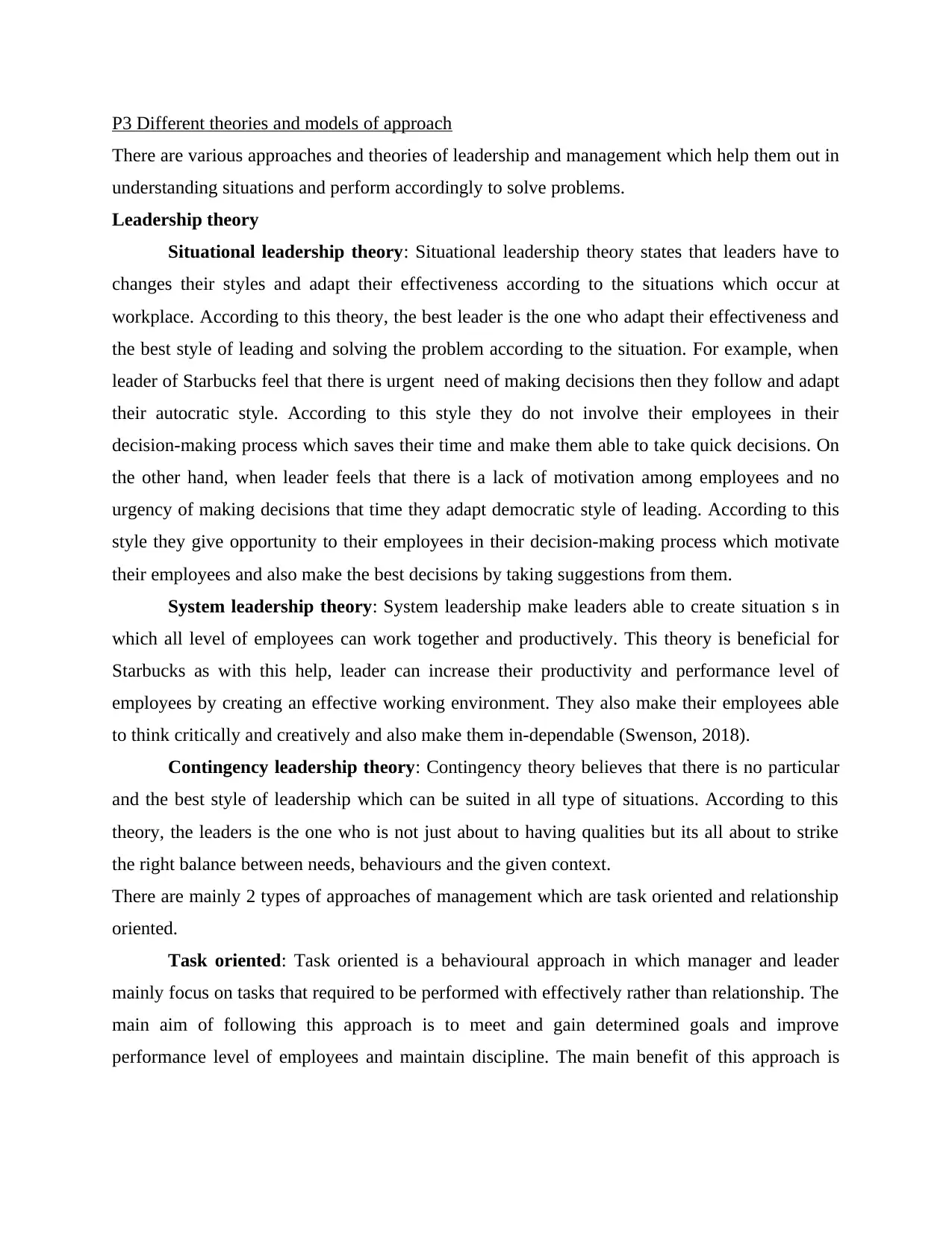
P3 Different theories and models of approach
There are various approaches and theories of leadership and management which help them out in
understanding situations and perform accordingly to solve problems.
Leadership theory
Situational leadership theory: Situational leadership theory states that leaders have to
changes their styles and adapt their effectiveness according to the situations which occur at
workplace. According to this theory, the best leader is the one who adapt their effectiveness and
the best style of leading and solving the problem according to the situation. For example, when
leader of Starbucks feel that there is urgent need of making decisions then they follow and adapt
their autocratic style. According to this style they do not involve their employees in their
decision-making process which saves their time and make them able to take quick decisions. On
the other hand, when leader feels that there is a lack of motivation among employees and no
urgency of making decisions that time they adapt democratic style of leading. According to this
style they give opportunity to their employees in their decision-making process which motivate
their employees and also make the best decisions by taking suggestions from them.
System leadership theory: System leadership make leaders able to create situation s in
which all level of employees can work together and productively. This theory is beneficial for
Starbucks as with this help, leader can increase their productivity and performance level of
employees by creating an effective working environment. They also make their employees able
to think critically and creatively and also make them in-dependable (Swenson, 2018).
Contingency leadership theory: Contingency theory believes that there is no particular
and the best style of leadership which can be suited in all type of situations. According to this
theory, the leaders is the one who is not just about to having qualities but its all about to strike
the right balance between needs, behaviours and the given context.
There are mainly 2 types of approaches of management which are task oriented and relationship
oriented.
Task oriented: Task oriented is a behavioural approach in which manager and leader
mainly focus on tasks that required to be performed with effectively rather than relationship. The
main aim of following this approach is to meet and gain determined goals and improve
performance level of employees and maintain discipline. The main benefit of this approach is
There are various approaches and theories of leadership and management which help them out in
understanding situations and perform accordingly to solve problems.
Leadership theory
Situational leadership theory: Situational leadership theory states that leaders have to
changes their styles and adapt their effectiveness according to the situations which occur at
workplace. According to this theory, the best leader is the one who adapt their effectiveness and
the best style of leading and solving the problem according to the situation. For example, when
leader of Starbucks feel that there is urgent need of making decisions then they follow and adapt
their autocratic style. According to this style they do not involve their employees in their
decision-making process which saves their time and make them able to take quick decisions. On
the other hand, when leader feels that there is a lack of motivation among employees and no
urgency of making decisions that time they adapt democratic style of leading. According to this
style they give opportunity to their employees in their decision-making process which motivate
their employees and also make the best decisions by taking suggestions from them.
System leadership theory: System leadership make leaders able to create situation s in
which all level of employees can work together and productively. This theory is beneficial for
Starbucks as with this help, leader can increase their productivity and performance level of
employees by creating an effective working environment. They also make their employees able
to think critically and creatively and also make them in-dependable (Swenson, 2018).
Contingency leadership theory: Contingency theory believes that there is no particular
and the best style of leadership which can be suited in all type of situations. According to this
theory, the leaders is the one who is not just about to having qualities but its all about to strike
the right balance between needs, behaviours and the given context.
There are mainly 2 types of approaches of management which are task oriented and relationship
oriented.
Task oriented: Task oriented is a behavioural approach in which manager and leader
mainly focus on tasks that required to be performed with effectively rather than relationship. The
main aim of following this approach is to meet and gain determined goals and improve
performance level of employees and maintain discipline. The main benefit of this approach is
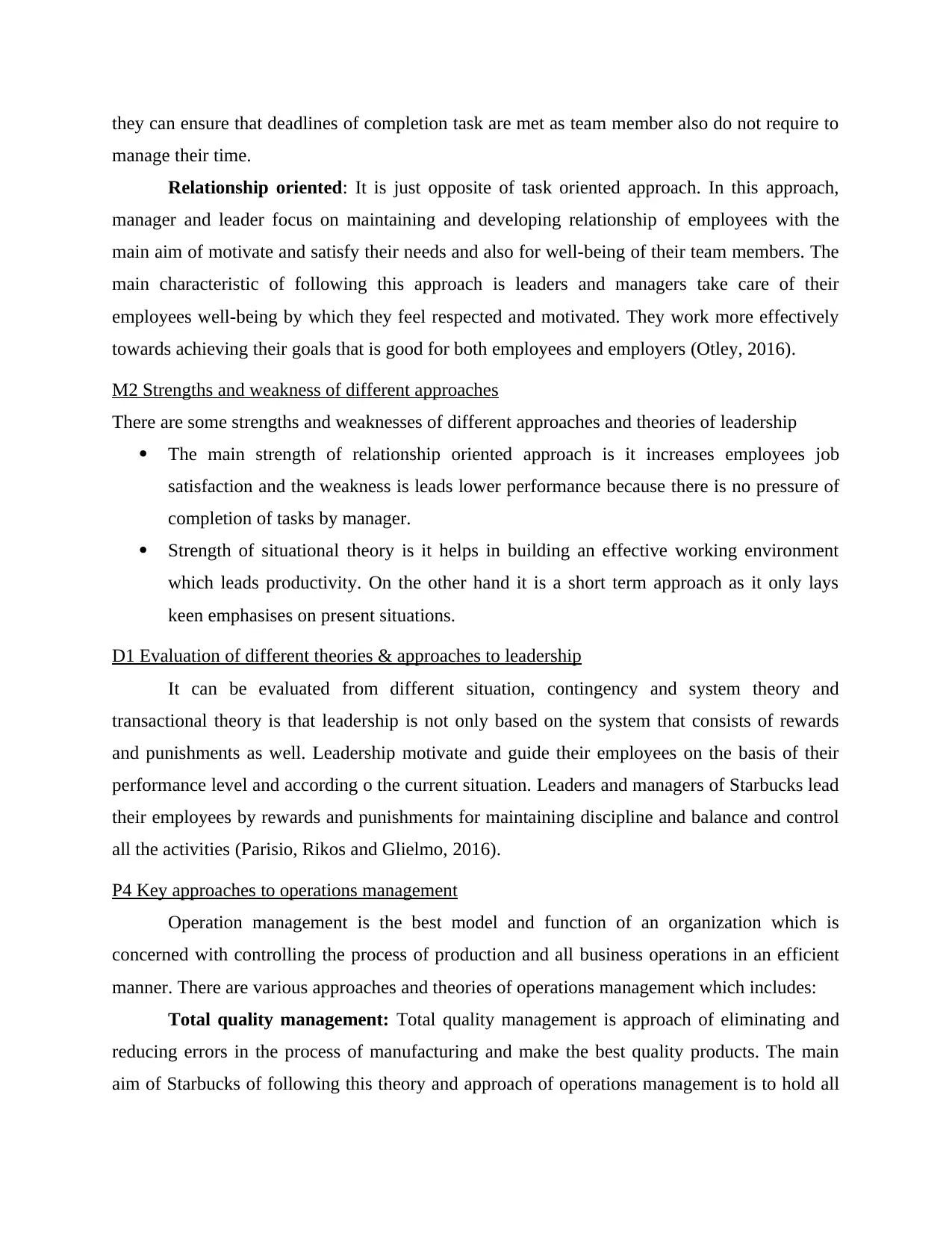
they can ensure that deadlines of completion task are met as team member also do not require to
manage their time.
Relationship oriented: It is just opposite of task oriented approach. In this approach,
manager and leader focus on maintaining and developing relationship of employees with the
main aim of motivate and satisfy their needs and also for well-being of their team members. The
main characteristic of following this approach is leaders and managers take care of their
employees well-being by which they feel respected and motivated. They work more effectively
towards achieving their goals that is good for both employees and employers (Otley, 2016).
M2 Strengths and weakness of different approaches
There are some strengths and weaknesses of different approaches and theories of leadership
The main strength of relationship oriented approach is it increases employees job
satisfaction and the weakness is leads lower performance because there is no pressure of
completion of tasks by manager.
Strength of situational theory is it helps in building an effective working environment
which leads productivity. On the other hand it is a short term approach as it only lays
keen emphasises on present situations.
D1 Evaluation of different theories & approaches to leadership
It can be evaluated from different situation, contingency and system theory and
transactional theory is that leadership is not only based on the system that consists of rewards
and punishments as well. Leadership motivate and guide their employees on the basis of their
performance level and according o the current situation. Leaders and managers of Starbucks lead
their employees by rewards and punishments for maintaining discipline and balance and control
all the activities (Parisio, Rikos and Glielmo, 2016).
P4 Key approaches to operations management
Operation management is the best model and function of an organization which is
concerned with controlling the process of production and all business operations in an efficient
manner. There are various approaches and theories of operations management which includes:
Total quality management: Total quality management is approach of eliminating and
reducing errors in the process of manufacturing and make the best quality products. The main
aim of Starbucks of following this theory and approach of operations management is to hold all
manage their time.
Relationship oriented: It is just opposite of task oriented approach. In this approach,
manager and leader focus on maintaining and developing relationship of employees with the
main aim of motivate and satisfy their needs and also for well-being of their team members. The
main characteristic of following this approach is leaders and managers take care of their
employees well-being by which they feel respected and motivated. They work more effectively
towards achieving their goals that is good for both employees and employers (Otley, 2016).
M2 Strengths and weakness of different approaches
There are some strengths and weaknesses of different approaches and theories of leadership
The main strength of relationship oriented approach is it increases employees job
satisfaction and the weakness is leads lower performance because there is no pressure of
completion of tasks by manager.
Strength of situational theory is it helps in building an effective working environment
which leads productivity. On the other hand it is a short term approach as it only lays
keen emphasises on present situations.
D1 Evaluation of different theories & approaches to leadership
It can be evaluated from different situation, contingency and system theory and
transactional theory is that leadership is not only based on the system that consists of rewards
and punishments as well. Leadership motivate and guide their employees on the basis of their
performance level and according o the current situation. Leaders and managers of Starbucks lead
their employees by rewards and punishments for maintaining discipline and balance and control
all the activities (Parisio, Rikos and Glielmo, 2016).
P4 Key approaches to operations management
Operation management is the best model and function of an organization which is
concerned with controlling the process of production and all business operations in an efficient
manner. There are various approaches and theories of operations management which includes:
Total quality management: Total quality management is approach of eliminating and
reducing errors in the process of manufacturing and make the best quality products. The main
aim of Starbucks of following this theory and approach of operations management is to hold all
⊘ This is a preview!⊘
Do you want full access?
Subscribe today to unlock all pages.

Trusted by 1+ million students worldwide
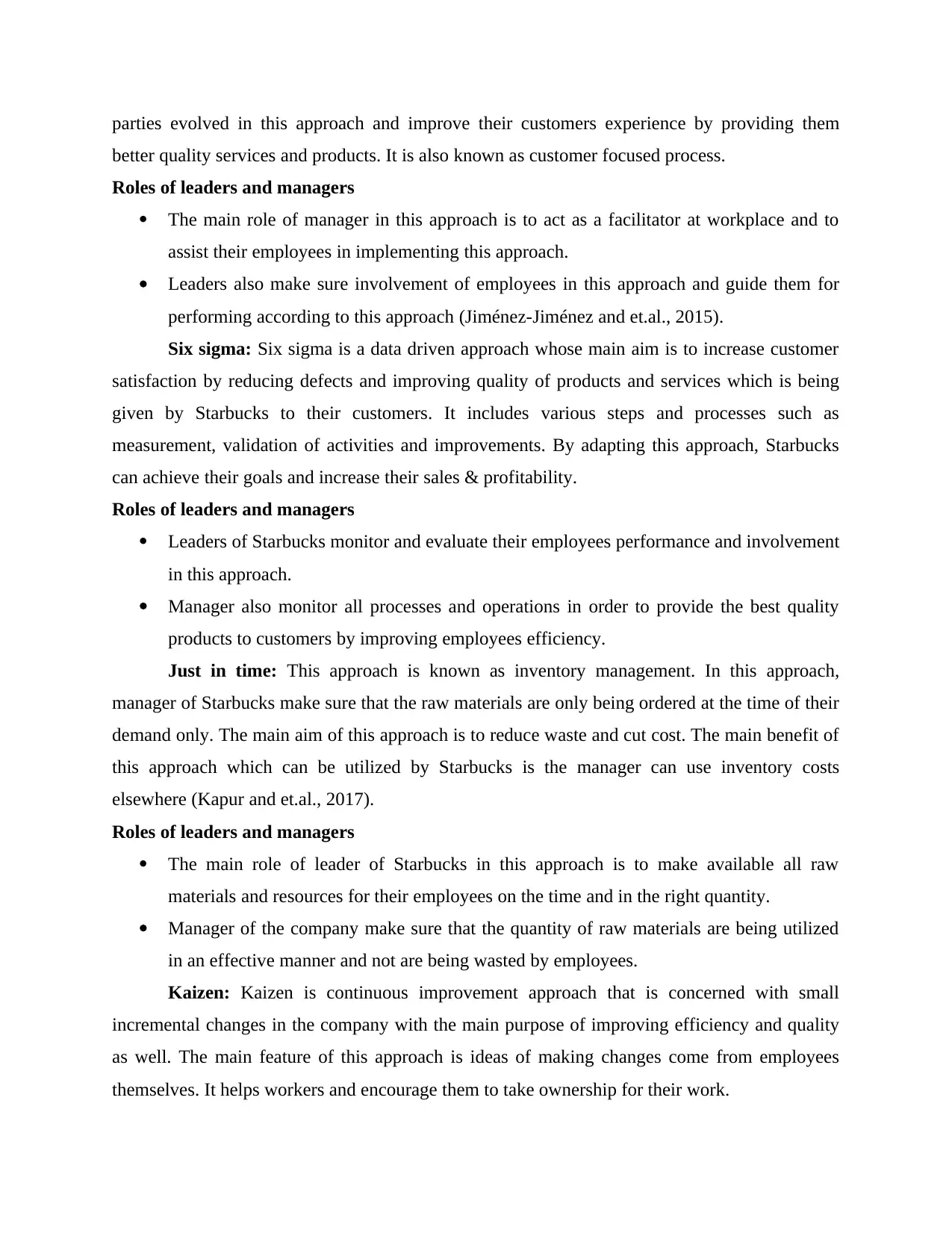
parties evolved in this approach and improve their customers experience by providing them
better quality services and products. It is also known as customer focused process.
Roles of leaders and managers
The main role of manager in this approach is to act as a facilitator at workplace and to
assist their employees in implementing this approach.
Leaders also make sure involvement of employees in this approach and guide them for
performing according to this approach (Jiménez-Jiménez and et.al., 2015).
Six sigma: Six sigma is a data driven approach whose main aim is to increase customer
satisfaction by reducing defects and improving quality of products and services which is being
given by Starbucks to their customers. It includes various steps and processes such as
measurement, validation of activities and improvements. By adapting this approach, Starbucks
can achieve their goals and increase their sales & profitability.
Roles of leaders and managers
Leaders of Starbucks monitor and evaluate their employees performance and involvement
in this approach.
Manager also monitor all processes and operations in order to provide the best quality
products to customers by improving employees efficiency.
Just in time: This approach is known as inventory management. In this approach,
manager of Starbucks make sure that the raw materials are only being ordered at the time of their
demand only. The main aim of this approach is to reduce waste and cut cost. The main benefit of
this approach which can be utilized by Starbucks is the manager can use inventory costs
elsewhere (Kapur and et.al., 2017).
Roles of leaders and managers
The main role of leader of Starbucks in this approach is to make available all raw
materials and resources for their employees on the time and in the right quantity.
Manager of the company make sure that the quantity of raw materials are being utilized
in an effective manner and not are being wasted by employees.
Kaizen: Kaizen is continuous improvement approach that is concerned with small
incremental changes in the company with the main purpose of improving efficiency and quality
as well. The main feature of this approach is ideas of making changes come from employees
themselves. It helps workers and encourage them to take ownership for their work.
better quality services and products. It is also known as customer focused process.
Roles of leaders and managers
The main role of manager in this approach is to act as a facilitator at workplace and to
assist their employees in implementing this approach.
Leaders also make sure involvement of employees in this approach and guide them for
performing according to this approach (Jiménez-Jiménez and et.al., 2015).
Six sigma: Six sigma is a data driven approach whose main aim is to increase customer
satisfaction by reducing defects and improving quality of products and services which is being
given by Starbucks to their customers. It includes various steps and processes such as
measurement, validation of activities and improvements. By adapting this approach, Starbucks
can achieve their goals and increase their sales & profitability.
Roles of leaders and managers
Leaders of Starbucks monitor and evaluate their employees performance and involvement
in this approach.
Manager also monitor all processes and operations in order to provide the best quality
products to customers by improving employees efficiency.
Just in time: This approach is known as inventory management. In this approach,
manager of Starbucks make sure that the raw materials are only being ordered at the time of their
demand only. The main aim of this approach is to reduce waste and cut cost. The main benefit of
this approach which can be utilized by Starbucks is the manager can use inventory costs
elsewhere (Kapur and et.al., 2017).
Roles of leaders and managers
The main role of leader of Starbucks in this approach is to make available all raw
materials and resources for their employees on the time and in the right quantity.
Manager of the company make sure that the quantity of raw materials are being utilized
in an effective manner and not are being wasted by employees.
Kaizen: Kaizen is continuous improvement approach that is concerned with small
incremental changes in the company with the main purpose of improving efficiency and quality
as well. The main feature of this approach is ideas of making changes come from employees
themselves. It helps workers and encourage them to take ownership for their work.
Paraphrase This Document
Need a fresh take? Get an instant paraphrase of this document with our AI Paraphraser
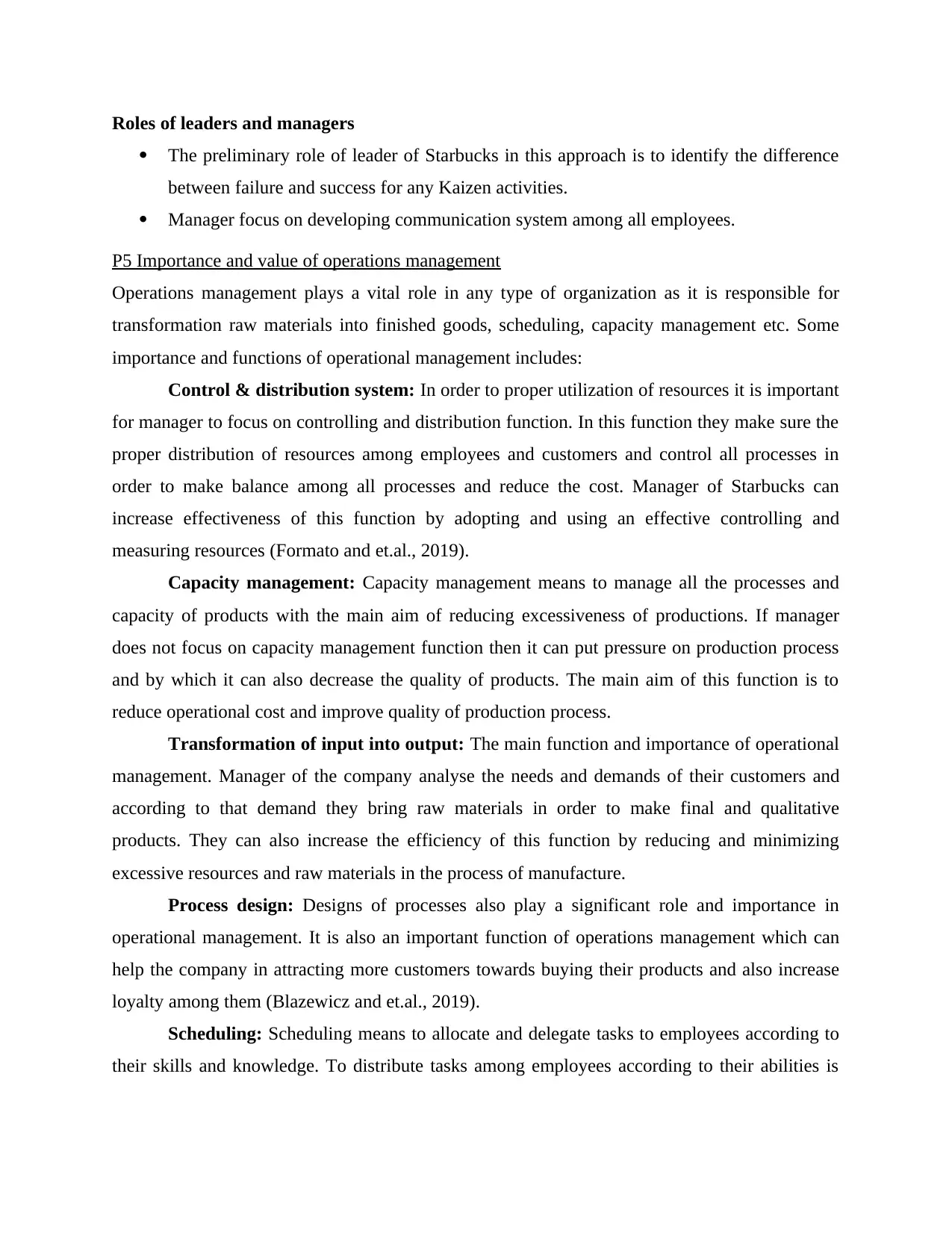
Roles of leaders and managers
The preliminary role of leader of Starbucks in this approach is to identify the difference
between failure and success for any Kaizen activities.
Manager focus on developing communication system among all employees.
P5 Importance and value of operations management
Operations management plays a vital role in any type of organization as it is responsible for
transformation raw materials into finished goods, scheduling, capacity management etc. Some
importance and functions of operational management includes:
Control & distribution system: In order to proper utilization of resources it is important
for manager to focus on controlling and distribution function. In this function they make sure the
proper distribution of resources among employees and customers and control all processes in
order to make balance among all processes and reduce the cost. Manager of Starbucks can
increase effectiveness of this function by adopting and using an effective controlling and
measuring resources (Formato and et.al., 2019).
Capacity management: Capacity management means to manage all the processes and
capacity of products with the main aim of reducing excessiveness of productions. If manager
does not focus on capacity management function then it can put pressure on production process
and by which it can also decrease the quality of products. The main aim of this function is to
reduce operational cost and improve quality of production process.
Transformation of input into output: The main function and importance of operational
management. Manager of the company analyse the needs and demands of their customers and
according to that demand they bring raw materials in order to make final and qualitative
products. They can also increase the efficiency of this function by reducing and minimizing
excessive resources and raw materials in the process of manufacture.
Process design: Designs of processes also play a significant role and importance in
operational management. It is also an important function of operations management which can
help the company in attracting more customers towards buying their products and also increase
loyalty among them (Blazewicz and et.al., 2019).
Scheduling: Scheduling means to allocate and delegate tasks to employees according to
their skills and knowledge. To distribute tasks among employees according to their abilities is
The preliminary role of leader of Starbucks in this approach is to identify the difference
between failure and success for any Kaizen activities.
Manager focus on developing communication system among all employees.
P5 Importance and value of operations management
Operations management plays a vital role in any type of organization as it is responsible for
transformation raw materials into finished goods, scheduling, capacity management etc. Some
importance and functions of operational management includes:
Control & distribution system: In order to proper utilization of resources it is important
for manager to focus on controlling and distribution function. In this function they make sure the
proper distribution of resources among employees and customers and control all processes in
order to make balance among all processes and reduce the cost. Manager of Starbucks can
increase effectiveness of this function by adopting and using an effective controlling and
measuring resources (Formato and et.al., 2019).
Capacity management: Capacity management means to manage all the processes and
capacity of products with the main aim of reducing excessiveness of productions. If manager
does not focus on capacity management function then it can put pressure on production process
and by which it can also decrease the quality of products. The main aim of this function is to
reduce operational cost and improve quality of production process.
Transformation of input into output: The main function and importance of operational
management. Manager of the company analyse the needs and demands of their customers and
according to that demand they bring raw materials in order to make final and qualitative
products. They can also increase the efficiency of this function by reducing and minimizing
excessive resources and raw materials in the process of manufacture.
Process design: Designs of processes also play a significant role and importance in
operational management. It is also an important function of operations management which can
help the company in attracting more customers towards buying their products and also increase
loyalty among them (Blazewicz and et.al., 2019).
Scheduling: Scheduling means to allocate and delegate tasks to employees according to
their skills and knowledge. To distribute tasks among employees according to their abilities is
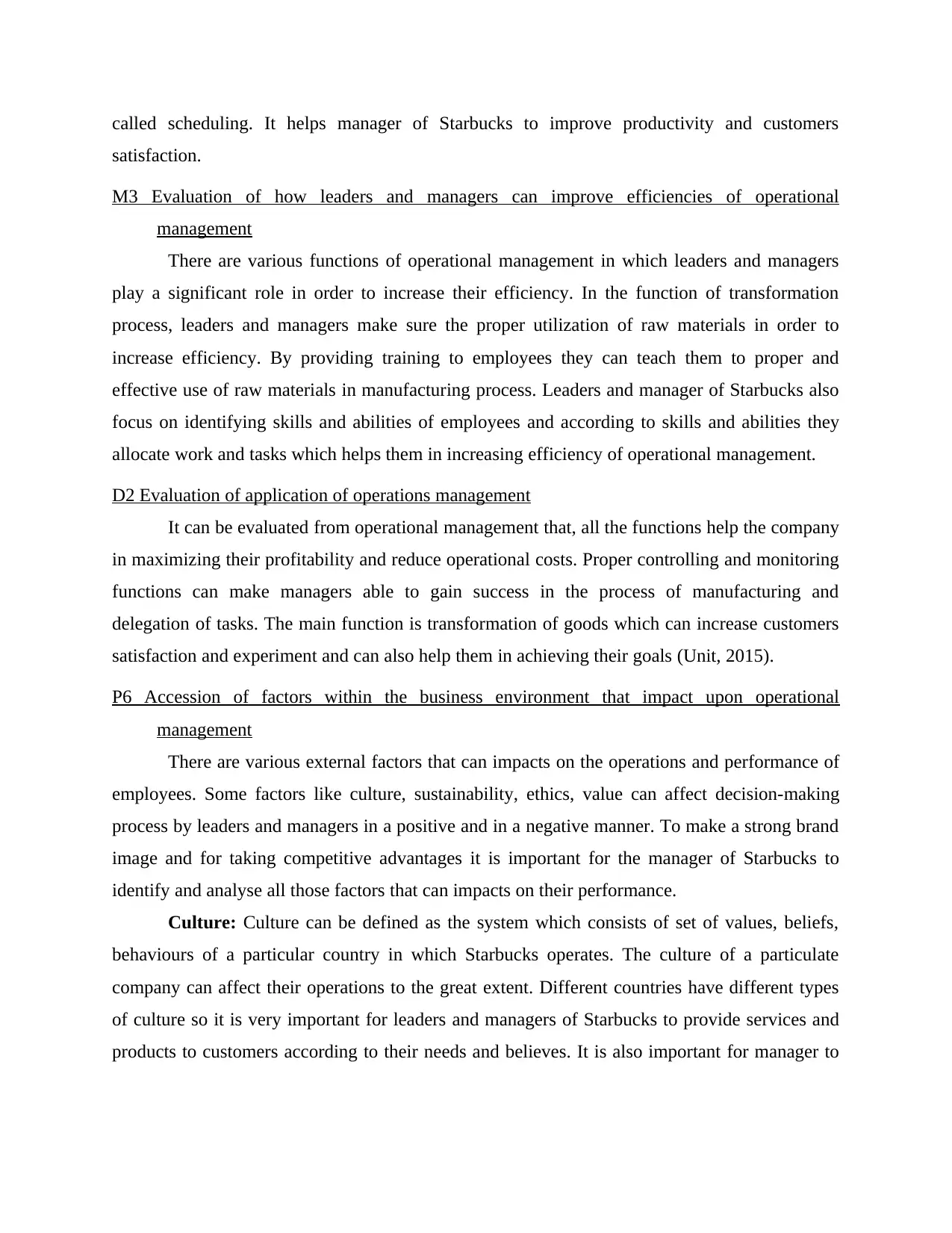
called scheduling. It helps manager of Starbucks to improve productivity and customers
satisfaction.
M3 Evaluation of how leaders and managers can improve efficiencies of operational
management
There are various functions of operational management in which leaders and managers
play a significant role in order to increase their efficiency. In the function of transformation
process, leaders and managers make sure the proper utilization of raw materials in order to
increase efficiency. By providing training to employees they can teach them to proper and
effective use of raw materials in manufacturing process. Leaders and manager of Starbucks also
focus on identifying skills and abilities of employees and according to skills and abilities they
allocate work and tasks which helps them in increasing efficiency of operational management.
D2 Evaluation of application of operations management
It can be evaluated from operational management that, all the functions help the company
in maximizing their profitability and reduce operational costs. Proper controlling and monitoring
functions can make managers able to gain success in the process of manufacturing and
delegation of tasks. The main function is transformation of goods which can increase customers
satisfaction and experiment and can also help them in achieving their goals (Unit, 2015).
P6 Accession of factors within the business environment that impact upon operational
management
There are various external factors that can impacts on the operations and performance of
employees. Some factors like culture, sustainability, ethics, value can affect decision-making
process by leaders and managers in a positive and in a negative manner. To make a strong brand
image and for taking competitive advantages it is important for the manager of Starbucks to
identify and analyse all those factors that can impacts on their performance.
Culture: Culture can be defined as the system which consists of set of values, beliefs,
behaviours of a particular country in which Starbucks operates. The culture of a particulate
company can affect their operations to the great extent. Different countries have different types
of culture so it is very important for leaders and managers of Starbucks to provide services and
products to customers according to their needs and believes. It is also important for manager to
satisfaction.
M3 Evaluation of how leaders and managers can improve efficiencies of operational
management
There are various functions of operational management in which leaders and managers
play a significant role in order to increase their efficiency. In the function of transformation
process, leaders and managers make sure the proper utilization of raw materials in order to
increase efficiency. By providing training to employees they can teach them to proper and
effective use of raw materials in manufacturing process. Leaders and manager of Starbucks also
focus on identifying skills and abilities of employees and according to skills and abilities they
allocate work and tasks which helps them in increasing efficiency of operational management.
D2 Evaluation of application of operations management
It can be evaluated from operational management that, all the functions help the company
in maximizing their profitability and reduce operational costs. Proper controlling and monitoring
functions can make managers able to gain success in the process of manufacturing and
delegation of tasks. The main function is transformation of goods which can increase customers
satisfaction and experiment and can also help them in achieving their goals (Unit, 2015).
P6 Accession of factors within the business environment that impact upon operational
management
There are various external factors that can impacts on the operations and performance of
employees. Some factors like culture, sustainability, ethics, value can affect decision-making
process by leaders and managers in a positive and in a negative manner. To make a strong brand
image and for taking competitive advantages it is important for the manager of Starbucks to
identify and analyse all those factors that can impacts on their performance.
Culture: Culture can be defined as the system which consists of set of values, beliefs,
behaviours of a particular country in which Starbucks operates. The culture of a particulate
company can affect their operations to the great extent. Different countries have different types
of culture so it is very important for leaders and managers of Starbucks to provide services and
products to customers according to their needs and believes. It is also important for manager to
⊘ This is a preview!⊘
Do you want full access?
Subscribe today to unlock all pages.

Trusted by 1+ million students worldwide
1 out of 18
Related Documents
Your All-in-One AI-Powered Toolkit for Academic Success.
+13062052269
info@desklib.com
Available 24*7 on WhatsApp / Email
![[object Object]](/_next/static/media/star-bottom.7253800d.svg)
Unlock your academic potential
Copyright © 2020–2025 A2Z Services. All Rights Reserved. Developed and managed by ZUCOL.





